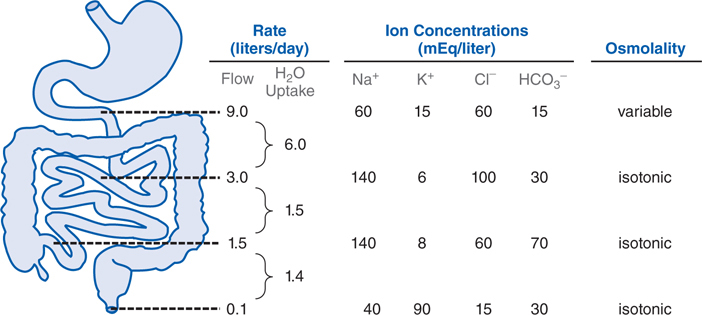33
Drugs Used for the Treatment of Bowel Disorders
The material in this chapter covers the material presented in Chapters 46 and 47 of Goodman and Gilman’s The Pharmacological Basis of Therapeutics, 12th Edition; this chapter will be most useful after having a basic understanding of these chapters in the 12th Edition. In addition to the material presented here, Chapters 46 and 47 of the 12th Edition contain:
• A description of gastric motility (see Chapter 46)
• A description of the pathophysiology of constipation (see Chapter 46), including Table 46-3 that provides a classification and comparison of representative laxatives, and Table 46-4 that shows the properties of different dietary fibers
• The general principles and approaches to the treatment of diarrhea (see Chapter 46)
• A general description of irritable bowel syndrome (IBS) (see Chapter 46)
• A pharmacological approach to the management of nausea and vomiting (see Chapter 46), including Table 46-6 that shows the receptor specificity of antiemetic agents, and Table 46-7 that shows some antiemetic regimens used in cancer chemotherapy and their initial doses
• A description of the pharmacological management of chronic pancreatitis and steatorrhea (see Chapter 46)
• The pathogenesis of inflammatory bowel disease (IBD) (see Chapter 47), including Table 47-1 which details medications commonly used to treat IBD
DRUGS INCLUDED IN THIS CHAPTER
• Adalimumab (HUMIRA)
• Alosetron (LOTRONEX)
• Alvimopan (ENTEREG)
• Aprepitant (EMEND)
• Azathioprine (IMMURAN)
• Balsalazide (COLAZIDE)
• Bisacodyl (DULCOLAX, CORRECTOL, others)
• Bismuth (OTC PEPTO-BISMOL)
• Budesonide (ENTOCORT ER)
• Carboxymethylcellulose
• Certolizumab pegol (CIMZIA)
• Cholestyramine (QUESTRAN, others)
• Cisapride (PROPULSID) available only in a limited-access program
• Cyclosporine
• Dexpanthenol (ILOPAN, others)
• Dicyclomine (BENTYL, others)
• Difenoxin (MOTOFEN)
• Diphenoxylate (LOMOTIL)
• Docusate sodium (COLACE, DOXINATE, others)
• Domperidone (MOTILIUM)—not available in the United States
• Dronabinol (MARINOL)
• Glycopyrrolate (ROBINUL, others)
• Hyoscyamine (LEVSIN, others)
• Infliximab (REMIDCADE)
• Lactulose (CEPHULAC, others)
• Loperamide (IMODIUM, others)
• Lubiprostone (AMITIZA)
• Mesalamine (5-aminosalicylic acid, 5-ASA)
• Methotrexate
• Methscopolamine (PAMINE, others)
• Methylnaltrexone (RELISTOR)
• Metoclopramide (REGLAN, others)
• Nabilone (CESAMET)
• Natalizumab (TYSABRI)
• Octreotide (SANDOSTATIN)
• Olsalazine (DIPENTUM)
• Ondansetron (ZOFRN, others)
• Polyethylene glycol (COLYTE, GOLYTELY, others)
• Prucalopride (RESELOR)—available in Europe for use in women with chronic constipation
• Saline laxatives
• Senna (SENOKOT, EX-LAX, others)
• Sulfasalazine (AZULFIDINE)
MECHANISMS OF ACTION OF LAXATIVES
• Enhanced retention of intraluminal fluid by hydrophilic or osmotic mechanisms
▶ Bulk-forming agents (bran, psyllium, etc); hydrophilic colloids (methylcellulose, etc)
▶ Osmotic agents (nonabsorbable inorganic salts or sugars)
▶ Stool-wetting agents (surfactants) and emollients (docusate)
• Decreased net absorption of fluid by effects on small- and large-bowel fluid and electrolyte transport
▶ Diphenylmethanes (bisacodyl)
▶ Anthraquinones (senna and cascara)
▶ Castor oil
• Altered motility by either inhibiting segmenting (nonpropulsive) contractions or stimulating propulsive contractions
▶ 5-HT4 receptor agonists
▶ Dopamine receptor antagonists
▶ Motilides (erythromycin)
LEARNING OBJECTIVES
 Describe the mechanisms of action of laxatives and cathartics, and understand their use.
Describe the mechanisms of action of laxatives and cathartics, and understand their use.
 Describe the mechanisms of action of antidiarrheal agents and understand their use.
Describe the mechanisms of action of antidiarrheal agents and understand their use.
 Understand the pharmacotherapy of IBS.
Understand the pharmacotherapy of IBS.
 Identify drugs used to treat nausea and vomiting, and describe the mechanisms of action of these drugs.
Identify drugs used to treat nausea and vomiting, and describe the mechanisms of action of these drugs.
 Identify the drugs used to treat IBD, their mechanisms of action, untoward effects, and understand how they are used to treat IBD.
Identify the drugs used to treat IBD, their mechanisms of action, untoward effects, and understand how they are used to treat IBD.
MECHANISMS OF ACTION OF DRUGS USED TO TREAT BOWEL DISORDERS
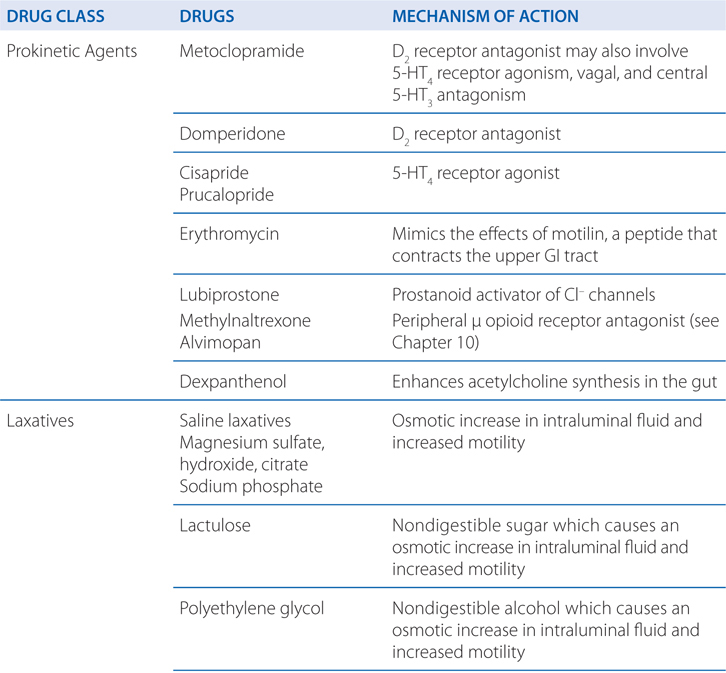
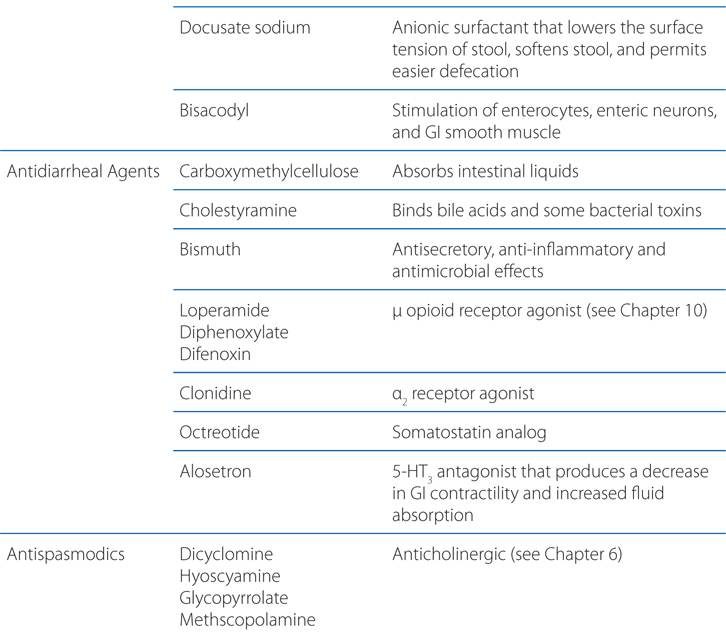
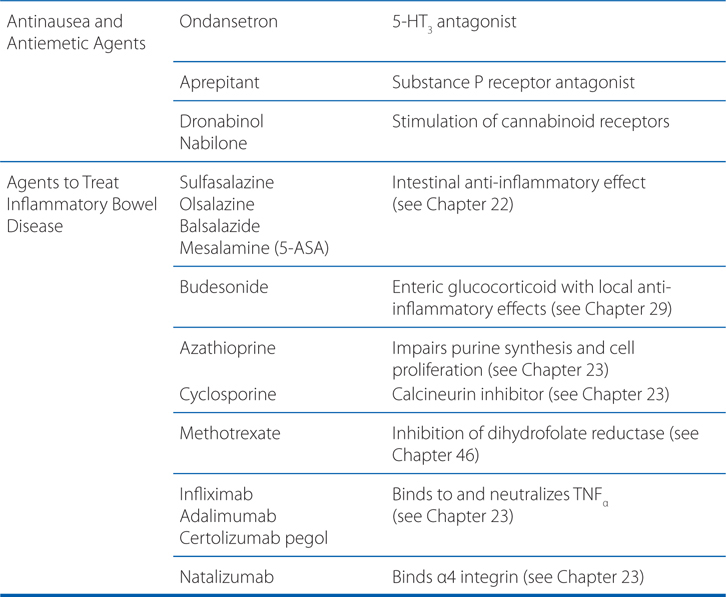
A 56-year-old man returns to his orthopedic surgeon 2 weeks after repair of a torn anterior cruciate ligament. He has had a considerable amount of pain and has been taking oral hydrocodone on a regular basis daily. He complains today of constipation manifested by decreased stool frequency and difficulty with his bowel movements.
a. What is the likely cause of his constipation?
Figure 33-1 shows the volume and composition of fluid that traverses the small and large intestine daily. Opiate analgesics such as hydrocodone reduce propulsatile activity in the small and large intestine, and decrease intestinal secretions (see Chapter 10). These actions lead to increased water absorption, increasing viscosity of bowel contents and constipation.
FIGURE 33-1 The approximate volume and composition of fluid that traverses the small and large intestines daily. Of the 9 L of fluid typically presented to the small intestine each day, 2 L are from the diet and 7 L are from secretions (salivary, gastric, pancreatic, and biliary). The absorptive capacity of the colon is 4 to 5 L per day.
b. What is a rational approach to this type of constipation?
Table 33-1 shows a classification of laxatives and Table 33-2 shows the effects of some laxatives on bowel function. In this case the constipation is specifically due to the use of an opioid narcotic for pain. Decreasing the use of the opiate narcotic should improve the situation. If this is not possible, increasing fiber in the diet as well as good hydration should be encouraged.
TABLE 33-1 Classification of Laxatives
1. Luminally active agents
Hydrophilic colloids; bulk-forming agents (bran, psyllium, etc)
Osmotic agents (nonabsorbable inorganic salts or sugars)
Stool-wetting agents (surfactants) and emollients (docusate, mineral oil)
2. Nonspecific stimulants or irritants (with effects on fluid secretion and motility)
Diphenylmethanes (bisacodyl)
Anthraquinones (senna and cascara)
Castor oil
3. Prokinetic agents (acting primarily on motility)
5-HT4 receptor agonists
Dopamine receptor antagonists
Motilides (erythromycin)
TABLE 33-2 Summary of Effects of Some Laxatives on Bowel Function
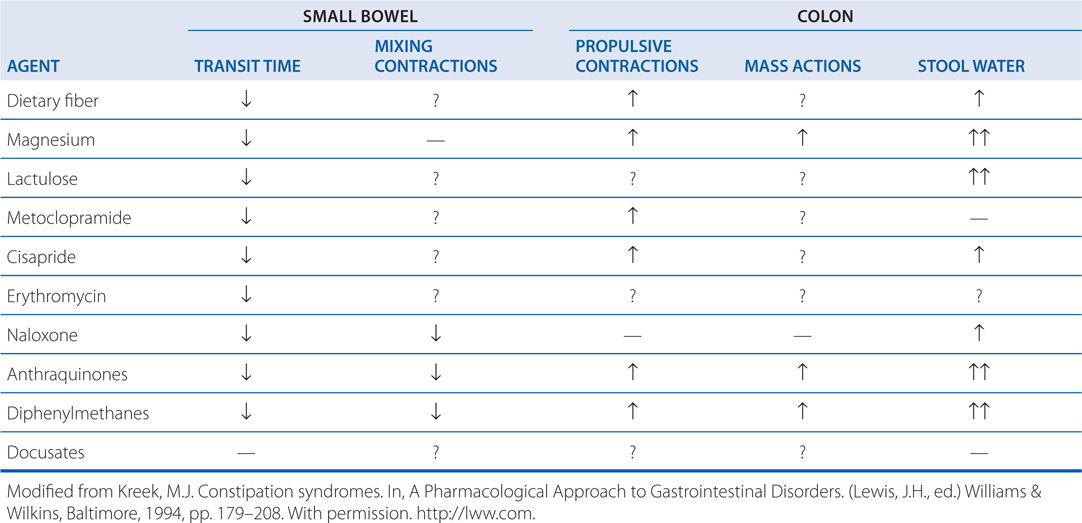
c. Is there an alternative if a high fiber diet is not effective?
Methylnaltrexone is a peripherally acting μ opioid receptor antagonist that specifically targets the underlying reason for the constipation, without limiting centrally produced analgesia.
CAUSES OF DIARRHEA
• Increased osmotic load within the intestine.
• Excessive secretion of electrolytes and water into the intestinal lumen.
• Exudation of protein and fluid from the intestinal mucosa.
• Altered intestinal motility resulting in rapid transit (and decreased fluid absorption).
Stay updated, free articles. Join our Telegram channel

Full access? Get Clinical Tree


